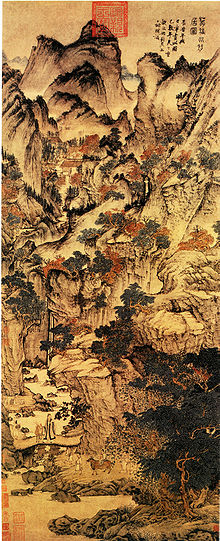art.wikisort.org - Artist
Wang Meng (王蒙, Wáng Méng; Zi: Shūmíng 叔明, Hao: Xiāngguāng Jūshì 香光居士) (c. 1308 – 1385) was a Chinese painter during the Yuan Dynasty.
This article uses bare URLs, which are uninformative and vulnerable to link rot. (August 2022) |

Biography
Wang Meng was born in Wuxing (吴兴), now known as Huzhou (湖州), Zhejiang. He was a maternal grandson of Zhao Mengfu, thus making him a descendant of the Song Dynasty's royal bloodline on his mother's side.
Wang Meng was erroneously accused of conspiring against the Ming Emperor Taizu and spent the last five years of his life in jail.[1]
Painting style
Wang Meng is considered to be one of the Four Masters of the Yuan Dynasty, along with Huang Gongwang, Wu Zhen, and Ni Zan. They famously refused to serve the Mongolian rulers of their country. In contrast to many renowned painters in previous history, these artists mostly worked on paper instead of silk, an indication of the importance they gave to the calligraphic touch of the brush on paper. They exclusively painted landscapes, which they believed to be the visible key to the invisible reality. They restricted their acquaintanceship to each other, and like-minded "wen ren" (gentleman-scholars).[2]
Wang Meng was the youngest of the group, and the least famous in his own time. Nevertheless, his style greatly influenced later Chinese painting. In contrast to the relatively spare style of his compatriots, his ropy brushstrokes piled one on the other to produce masses of texture combined in dense and involved patterns.[3] Many artists were influenced by the works of Wang Meng centuries after his death, most notably Dong Qichang.[4]
His most famous works are the Ge Zhichuan Relocating, Forest Grotto at Juqu, Writing Books under the Pine Trees, The Simple Retreat, and Dwelling in the Qingbian Mountains. Most of his masterpieces are now located in notable museums around the world, such as the Palace Museum, National Palace Museum, Shanghai Museum, Cleveland Museum of Art and the Metropolitan Museum of Art.[5] In 2011, a lesser known work of his from a private collection, titled Zhichuan Resettlement, was sold for 402.5 million yuan (US$62.1 million) at art auction.[6]
- Writing Books under the Pine Trees, Cleveland Museum of Art
- Forest Grotto in Juqu, National Palace Museum
- Dwelling in the Qingbian Mountains, Shanghai Museum
- The Simple Retreat, Metropolitan Museum of Art
Footnotes
- "Masters:Wang Meng". chinaonelinemuseum.com. Retrieved 14 November 2017.
- Lee, Pages 460-463
- Lee, Pages 466-467
- Lee, Page 467
- Lee Page 467
- http://en.artron.net/news/news.php?newid=171277
References
- Lee, Sherman E. (1994), A History of Far Eastern Art, (5th ed.), Harry N. Abrams Inc., New York, NY
External links
- Wang Meng and his painting gallery at China Online Museum
- Landscapes Clear and Radiant: The Art of Wang Hui (1632-1717), an exhibition catalog from The Metropolitan Museum of Art (fully available online as PDF), which contains material on Wang Meng (see index)
- Sung and Yuan paintings, an exhibition catalog from The Metropolitan Museum of Art Libraries (fully available online as PDF), which contains material on Wang Meng (see list of paintings)
На других языках
[de] Wang Meng (Maler)
Wang Meng (chinesisch .mw-parser-output .Hani{font-size:110%}王蒙, Pinyin Wáng Méng; * 1308; † 1385) war ein chinesischer Landschaftsmaler des 14. Jahrhunderts, der im Westen vor allem dadurch bekannt wurde, dass 2011 ein Bild namens Umzug Zhichuans für 402,5 Millionen Yuan (62,1 Millionen US$) verkauft wurde, zum damaligen Zeitpunkt knapp hinter einem Werk Qi Baishis das zweitteuerste Bild eines Asiaten aller Zeiten.- [en] Wang Meng (painter)
[es] Wang Meng
Wang Meng (1308 - 1385) fue un pintor chino durante la Dinastía Yuan, estando considerado uno de los cuatro grandes maestros de esa dinastía.[fr] Wang Meng (peintre)
Wang Meng (王蒙, v. 1308 — v. 1385) est un peintre chinois de la fin de la dynastie Yuan (1279–1368). On le considère comme un des « quatre maîtres » de période Yuan, avec Huang Gongwang, Wu Zhen, et Ni Zan.[it] Wang Meng (pittore)
Wang Meng[1] (王蒙T, Wáng MéngP; Huzhou, 1308 – Nanchino, 1385) è stato un pittore cinese. Il suo zi era Shūmíng (叔明), i suoi hao erano invece Huánghè Shānqiáo (黃鶴山樵) e Xiāngguāng Jūshì (香光居士).[ru] Ван Мэн (художник)
Ван Мэн (кит. упр. 王蒙, ок.1308 — 1385) — китайский художник и поэт.Другой контент может иметь иную лицензию. Перед использованием материалов сайта WikiSort.org внимательно изучите правила лицензирования конкретных элементов наполнения сайта.
WikiSort.org - проект по пересортировке и дополнению контента Википедии

